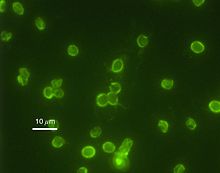Cryptosporidium parvum is one of several species that cause cryptosporidiosis, a parasitic disease of the mammalian intestinal tract.[1]
Primary symptoms of C. parvum infection are acute, watery, and nonbloody diarrhea. C. parvum infection is of particular concern in immunocompromised patients, where diarrhea can reach 10–15 times per day. Other symptoms may include anorexia, nausea/vomiting, and abdominal pain. Extra-intestinal sites include the lung, liver, and gall bladder, where it causes respiratory cryptosporidosis, hepatitis, and cholecystitis, respectively.[citation needed]
Infection is caused by ingestion of sporulated oocysts transmitted by the faecal-oral route. In healthy human hosts, the median infective dose is 132 oocysts.[2] The general C. parvum lifecycle is shared by other members of the genus. Invasion of the apical tip of ileal enterocytes by sporozoites and merozoites causes pathology seen in the disease.[citation needed]
Infection is generally self-limiting in immunocompetent people. In immunocompromised patients, such as those with AIDS or those undergoing immunosuppressive therapy, infection may not be self-limiting, leading to dehydration and, in severe cases, death.[citation needed]
| Cryptosporidium parvum | |
|---|---|
 | |
| Immunofluorescence image of C. parvumoocysts |
https://en.wikipedia.org/wiki/Cryptosporidium_parvum
No comments:
Post a Comment